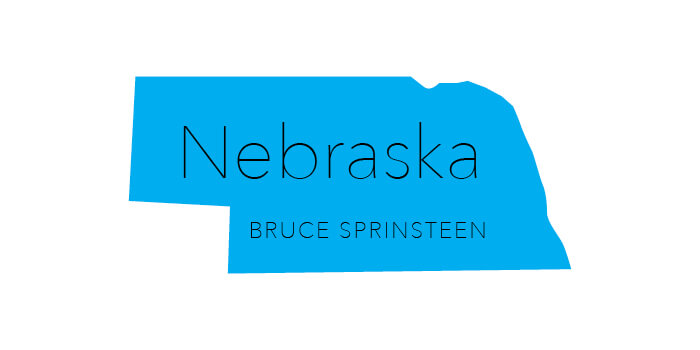Musical Map of the USA: Nebraska—Bruce Springsteen




http://open.spotify.com/track/7GDIQqD5pdHCda5rpZ98Ie
For those of us who grew up in dead-end Northeastern towns, he was a prophet able to capture the realities of the streets around us while also painting those wild, romantic portraits of that something else out in America. The ones that, even if we got older and realized the already-existent disenchantment that necessitated the attempted escape of Born To Run in the first place, we were grateful to have as dreams anyway.
Every now and then, the vague promise of the American frontier—sometimes enticing, sometimes hollow and broken, depending on the song/album—resulted in songs that specifically touched on other parts of the country than Springsteen’s home state. Some of these feel like tangents—like the Southwestern tourism of The Ghost Of Tom Joad that resulted from Springsteen’s stint living in Los Angeles—that play like spin-offs within the sprawl of Springsteen’s work. Then there’s Nebraska, part of Springsteen’s iconic run, the one named for the desolation out in the middle of America with which, if you continued down the highway at the end of “Thunder Road,” you would eventually have to reckon.
Released in 1982, Nebraska was the album of sparse, mostly acoustic demoes Springsteen released in lieu of another full E Street Band record between the increased pop clout resulting from 1980’s The River, and the moment where he’d truly become a superstar phenomenon with 1984’s Born In The U.S.A.. It remains his darkest album if we’re talking about straight-up bleakness–there’s Darkness On The Edge Of Town‘s righteous anger, Tom Joad‘s plaintive reportage, and Tunnel Of Love‘s divorce-album/fame-freakout “What’s it all been worth?” grief.
But Nebraska is the haunted and haunting counter-narrative crucial to fleshing out Springsteen’s discography, turning his fascination with the American landscape into hyperreal ghost stories. His voice is hushed throughout the record, an apparition trying to convey forbidden American truths. The title of the album comes from a song in which Springsteen tells a story from the perspective of Charles Starkweather, a 19-year-old who, with his girlfriend, went on a killing spree in Nebraska and Wyoming in the late ’50s. That’s what the American frontier means on Nebraska: no longer adventure, but violence and hopelessness.
The expanse of America beyond the East Coast was often figured as the Other Place in Springsteen’s early work, much as it has been in plenty of other American art. While we might tirelessly mythologize LA and NYC, the simultaneous wonder and brutality of an untamed continent has always been a primary engine of the American imagination. We could seek the mystery out there, or we could fill up all that space with meaning that helped crystallize our identity back here.
For Springsteen, it was the dream of bigger cities and new lives, of Golden Coasts and endless roads. It was a fantasy culled from geographical realities. Mostly, there was that romance to it, even when Springsteen as a songwriter (and his narrators) started to mature and acknowledge that the escape at the end of the highway isn’t going to solve all your problems.
Yet Nebraska does something more extreme than any other album in his catalog. With that stark black and white cover and the eerie whisper of the title track, Springsteen conjures the flat, endless plains of Nebraska as entirely alien. It zeroes in on the specters lingering in the shadows and at the edges of this country’s identity, using the blank wilderness of Nebraska as a template for exploring defeat and destruction in a more explicit fashion than anywhere else in his catalog.
There’s a twist underlying the whole project, though. At the same time that Nebraska looks further afield for Springsteen, it is less an album about travel and far away places than it is about people more trapped than Springsteen’s other protagonists, and the decisions they make in those contexts. Meaning: he brings the ghosts back home. We’re in Lincoln, Nebraska on the opening track, and by the next one they blew up the Chicken Man in Philly last night, and Atlantic City is the destination.
Other specific Jersey references litter the album, and tracks like “Mansion On The Hill” and “My Father’s House” are cut from the same cloth as anything else inspired by Springsteen’s youth in the Garden State. By “Open All Night,” he’s raging underneath Jersey’s “industrial skyline” and running from the “lunar landscape” of Jersey’s morning, before the climax of him proclaiming “Hey, ho, rock ‘n’ roll, deliver me from nowhere.” It’s a car song, it’s a rambling song–Springsteen has a lot of those.
But with “Nebraska” he tears open something deeper and darker, looking outward into the horizon and letting a new sickness, a new desperation spread out across the familiar turnpikes and boardwalks of a Jersey we’d already visited with him so many times before. He took the iconography of a far-off portion of the country, made it foreign, and then filtered his favored locales and stories through that. On Nebraska, he turned all of America–the familiar, and the unfamiliar–into nowhere. Once upon a time, nowhere meant hunger, and it meant flight, and it might’ve meant disappointment and stubbornness. This time it just meant nowhere, and all the things that could hide in it. This time, there was no deliverance.
This is one of more than 50 posts that make up our musical map of the United States, published by region—the West, Midwest, South, and Northeast—by writers who have strongly associated a song with a state.
[sc name=”nattysaw4″ ]
You might also like 



















